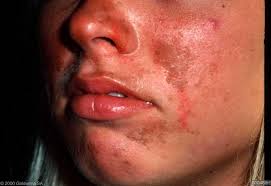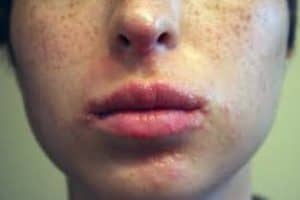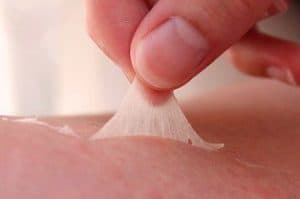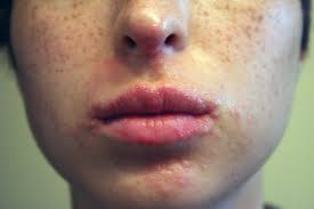What are the symptoms of sun poisoning? Read on to get more insights into what does sun poisoning looks like, in children, toddlers and adults.
| Photo | Title | More info |
|---|---|---|

|
Sun Bum Baby Mineral Sunscreen Lotion | SPF 50 | UVA, UVB Face and Body Protection | Fragrance Free Safe for Sensitive Skin | Travel Size | 3 Ounce | Pack of 2 | More info |

|
Aveeno Baby Continuous Protection Zinc Oxide Mineral Sunscreen Lotion for Sensitive Skin, Broad Spectrum SPF 50, Paraben- & Tear-Free, Sweat- & Water-Resistant, Travel-Size, 2 x 3 fl. oz | More info |
* As an Amazon Associate I earn from qualifying purchases.
What does Sun poisoning look like?
When you get exposed to the sun your body may react to the sunburn effect in various ways. Normally there is a formation of a rush that looks different depending on the causes and the duration of exposure. Various symptoms can describe sun allergy in various ways. Sun poisoning is a severe type of sunburn. Reddening of the skin, the formation of blisters, swelling and skin pill is among the effects of sun poisoning on the face and other exposed parts of the body.
When you look at the post on what is sun poisoning, you will learn that there are harmful UV is UVB radiations from the sun which are capable of penetrating the skin hence causing harm to the skin cells and some underlying tissues and organs. Skin aging and the risk of cancerous tumors are among the harmful effects of sun poisoning.
First aid is the first treatment for sun poisoning. There are various home remedies that can help fix the situation. Chronic sun poisoning requires emergency medical conditions since such a case can be life-threatening besides permanent deformation of the skin structure. Here are various symptoms of sun poisoning that you should be aware of so that you can take an appropriate measure.

What Are the Symptoms of Sun Poisoning?
Generally, sun poisoning will begin with skin reddening pain, and irritation. After a few hours of exposure to the sun, you will start seeing your skin turning reddish and irritation will eventually follow. This is especially for mild cases that involve exposure of 2 to 6 hours in the sun.
Chronic sunburn will take place when you are in the sun for 12 to 24 hours. This will associate symptoms such as the formation of blisters, swelling, dehydration, loss of balance, dizziness, and possibly a chronic infection. Such too much sun exposure can lead to permanent skin burning due to denaturing of cells, impair circulation of fluids in the body, fainting, and even death.
Depending on the intensity of the sunlight, you can also get chills, fever, vomiting, and skin peeling. Blisters and rash are so common especially in fair skin that has little melanin pigment. Both blisters and rashes can vary in size ranging from very fine to coarse. There are two types of sun poisoning and each associates specific symptoms.
Polymorphous light eruption (PMLE)
This is a reaction of the body after exposure to the sunlight you are not used to. It is not associated to any drugs or diseases. Native Americans are at high risk of getting affected with an inherent type of this type of sunburn. People in northern climates can get affected by PMLE especially when they are subjected to tropical climate.
It is characterized by a severe rash on the skin that surfaces past few hours of sun exposure. These rushes cause itching and they associate symptoms such as:
- Formation of small bumps over the sun-exposed areas of the skin and body.
- Development of dense clumps of bumps.
- Formation of hives on the chest, lower legs, and arms.
- Fatigue, Chills, headache, and nausea are also common.
The symptoms last 2 to 3 days although for some people it can persist for a week. Severe Polymorphous light eruption requires emergency treatment since it can be life-threatening at this level. Prevention of your body while getting outdoors is the best way to avoid PMLE. Sunscreen, wide-brimmed hat, and long-sleeved tops and pants should be used while in sun.
Solar urticaria
This is another common type of sun poisoning that forms after a few minutes of sun exposure. Symptoms of sun poisoning for this case include Itching, Wheezing, redness, blisters, loss of consciousness, the formation of bumps that look like hives, and dizziness. Symptoms may subside after a couple of days though for chronic cases they can persist and you are recommended to seek medical care.

Symptoms of Sun Poisoning Rash
Red, itch, and painful skin can be a sign of sun poisoning rash. This is a way of the body reacting to the heating effect and harmful radiation from the sun. Unprotected sun exposure can cause the formation of the rush within 30 minutes of exposure. Other risk factors for sunburn rush include the use of some types of medicines and skin products that makes the skin vulnerable to sun poisoning.
Symptoms of skin poisoning rash include; formation of small red and itchy bumps on the face or skin, blisters of different sizes, headache, nausea, fever, chills, and dizziness. Depending on the heating intensity and exposed duration, symptoms can be mild or chronic. Mild symptoms may subside within a couple of days following a first aid or application of sun poisoning home remedy.
Severe and chronic sun poisoning rush can be persistent as well associating other skin blemishes such as moles, freckles, and uneven skin tone. Various treatment for sun poisoning methods can be used in managing the situation. Sun poisoning prevention is the most recommended way of fixing and avoiding further problems.
Sun Poisoning Symptoms in Children

Children and young adults are at high risk of sunburn and sun poisoning compared to aged people. This is due to the soft growing nature of the skin and too much outdoor activity involvement. Aged people have tough strong skin that can resist some of the effects of unprotected sun exposure.
Most of the discussed symptoms will be observed in children depending on the cause, type and duration of exposure to the sunlight. Various discussed treatments for sun poising can be used in fixing the symptoms. Sun poisoning on the face can also be prevented using various explained methods on how to prevent sunburn. Home remedies and first aid can help in managing symptoms in children within a few hours of surfacing.
Symptoms of Sun Poisoning in Toddlers
Exposing young children to the sun can really affect both their eyes and skin. Toddlers have low production of melanin and tender skin cells that are highly vulnerable to harsh environmental conditions such as sunburn and sun poisoning. Symptoms are likely to be more severe in such young children as compared to adults.
When a child is exposed to the sun their heat rash will develop as an immediate symptom. It is characterized by pink or red discoloration in most areas of the body. There is also a high possibility of the onset of headaches, vomiting, dehydration, dizziness, fever, and chills.
Keeping your baby covered or indoors is the best way to avoid sun poisoning symptoms that can lead to more complicated infections. Unfortunately, most of the sun poisoning treatments used among adults may not be applicable to toddlers. For example, you are not advised to apply sunscreen on children of 6 to 12 months. When you accidentally expose your baby to the sun and you observe symptoms seek a doctor’s advice on what to do.
- FORMULATED FOR OUR RAD LITTLE KIDS: Specifically formulated for kids, toddlers and babies with naturally moisturizing ingredients, such as natural zinc oxide, coconut oil and shea and cocoa butter.
- MINERAL SUNSCREEN LOTION: 100% Mineral Based Protection. Applies and absorbs easily to face and body with a non-oily feel. UVA and UVB Broad Spectrum Protection, lightweight, and non-greasy, our SPF 50 sunscreen face stick is made of safe minerals to protect babies skin. Water Resistant (80 mins).
- HIGH QUALITY WITH NATURAL INGREDIENTS: Our plant-based formula contains coconut oil and shea and cocoa butter to nourish and hydrate all skin types. Fragrance Free, No Dyes, Cruelty Free, Gluten Free.
- PEDIATRICIAN & DERMATOLOGIST TESTED: Carefully tested for the needs of delicate baby skin. Baby Bum Sunscreen is Hypoallergenic, Paraben Free, Sulfate Free, Silicone Free and Phthalate Free.
- DUKES TIPS: Apply 15 minutes before sun time. Dispense into hands and apply directly to skin, covering all areas, and rub in until absorbed. Reapply after 80 minutes of swimming or sweating, and immediately after a towel dry. Use with our Face Stick for convenient, get-out-the door faster application.
* As an Amazon Associate I earn from qualifying purchases.
In conclusion, severe symptoms of sun poisoning can associate with serious complications such as cancerous skin tumors and permanent skin damage. Before thinking of treatment and home remedies, first, think about how to prevent and avoid too much exposure to the sun.
- Twin pack with two 3-fluid ounce tubes of Aveeno Baby Continuous Protection Sensitive Skin Sunscreen Lotion with SPF 50 for superior broad spectrum protection from harmful UVA and UVB rays for your little one's skin
- This effective mineral sunscreen lotion is as mild as water to skin and applies to baby's skin easily to lock in moisture without stinging or irritation. It's suitable for use on both the face and body
- Specially formulated for baby's delicate skin, it contains naturally-sourced 100% zinc oxide active ingredient and skin-soothing oat, and is both sweat- and water-resistant for up to 80 minutes
- From the pediatrician-recommended brand, this sunscreen lotion features a tear-free formula that is non-greasy, hypoallergenic and paraben-free, phthalate-free and fragrance-free. It is available in a convenient, TSA-friendly travel size
- The baby sunscreen has been awarded the National Eczema Association Seal of Acceptance and is recommended by the Skin Cancer Foundation as an effective broad spectrum sunscreen. Use anywhere from in the backyard to at daycare to protect baby from the sun
* As an Amazon Associate I earn from qualifying purchases.
Recent Posts
If you’re looking for the simplest, cheapest and best way to get that cleansed and nourished skin in no time, you definitely have to consider some of the best facial steamers for home. With the...
What is the best skin lightening cream for dark skin marks, African Americans? Get more insights on the most effective skin whitening cream and lotions for dark skin marks, pigmentation and acne...

